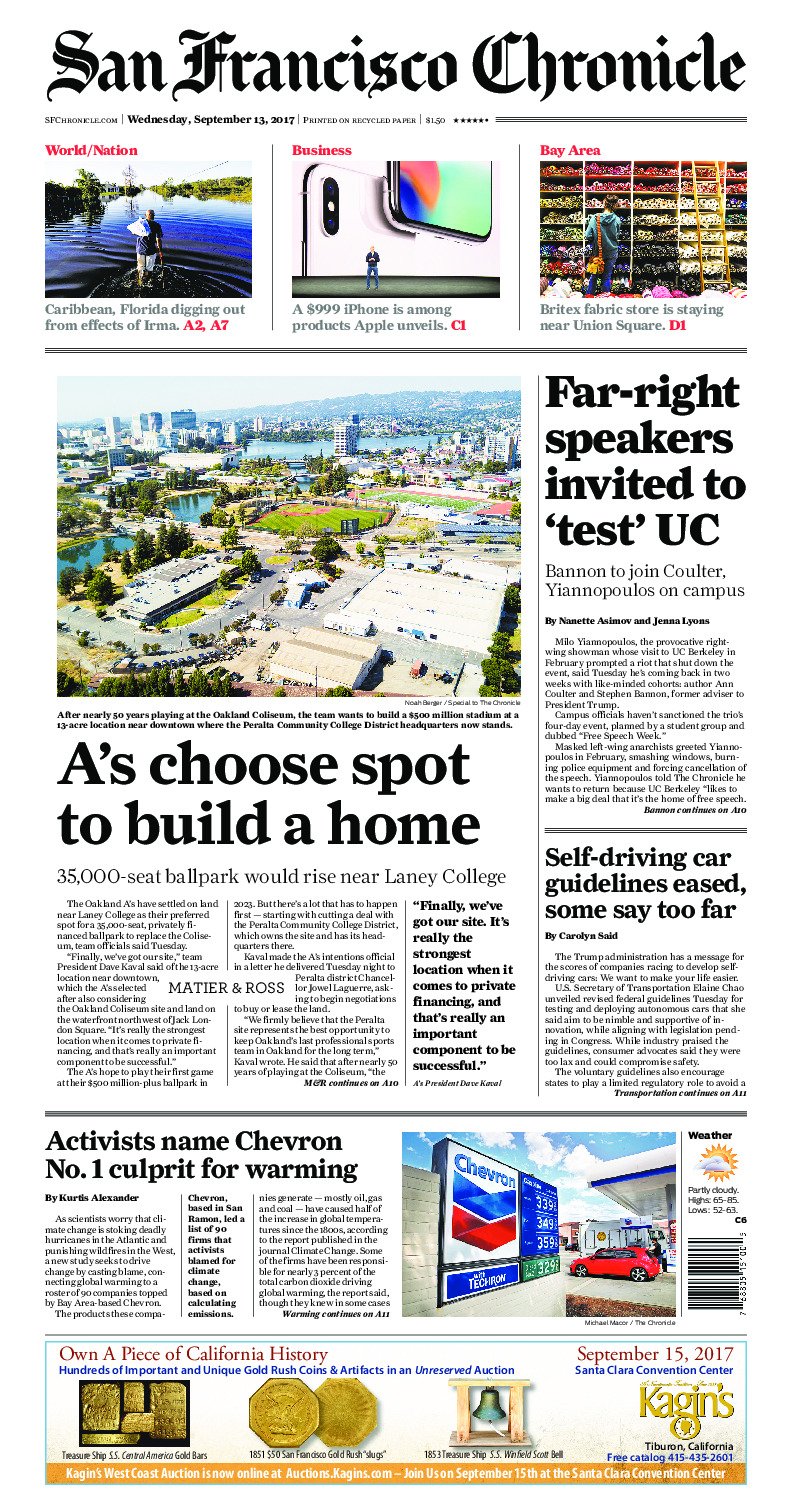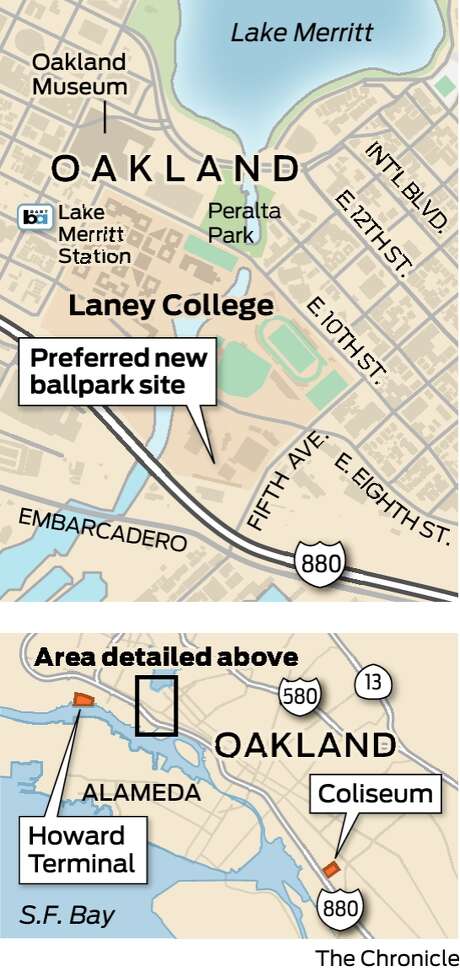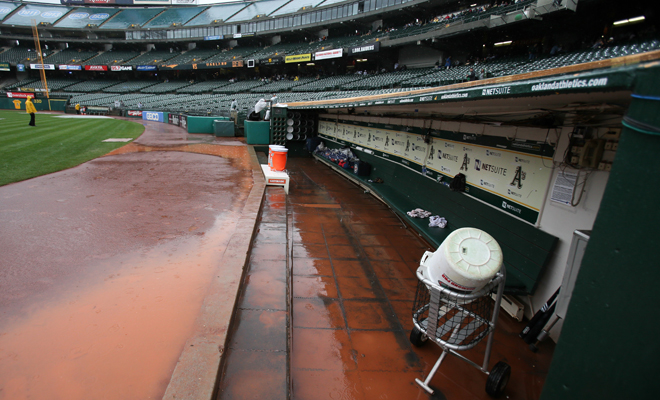

http://www.sfchronicle.com/bayarea/...3239.php?cmpid=twitter-premium#photo-14097837The Oakland A's have settled on land near Laney College as their preferred spot for a 35,000-seat, privately financed ballpark to replace the Coliseum, team officials said Tuesday.
”Finally, we've got our site," team President Dave Kaval said of the 13-acre location near downtown, which the A's selected after also considering the Oakland Coliseum site and land on the waterfront northwest of Jack London Square. ”It's really the strongest location when it comes to private financing, and that's really an important component to be successful."
The A's hope to play their first game at their $500 million-plus ballpark in 2023. But there's a lot that has to happen first — starting with cutting a deal with the Peralta Community College District, which owns the site and has its headquarters there.
Kaval made the A's intentions official in a letter he delivered Tuesday night to Peralta district Chancellor Jowel Laguerre, asking to begin negotiations to buy or lease the land.
”We firmly believe that the Peralta site represents the best opportunity to keep Oakland's last professional sports team in Oakland for the long term," Kaval wrote. He said that after nearly 50 years of playing at the Coliseum, ”the A's need a modern venue so that we can put the most competitive product on the field and provide the best experience for our fans."
The site has several features the A's made clear were a priority in their hunt for a new stadium location. It's right off Interstate 880, although providing vehicle access will require millions of dollars worth of new freeway ramps. It's also close to BART — the Lake Merritt Station is a nine-minute walk to the north — and it's on the edge of downtown.
To try to win over the Peralta district's Board of Trustees, the A's are proposing to construct housing and commercial space on an 8-acre Laney parking lot just north of the site — a spot now known for its Sunday morning flea market — and funnel revenue from it to Laney. The A's would also help build a garage there with the idea of boosting the college's overall parking capacity.
”We believe there are opportunities for mixed-use development ... that could generate significant long-term revenue to support the college's educational mission, and deliver a valuable and comprehensive community benefits package," Kaval said in his letter.
As for the Coliseum, which would have no professional sports tenants with the expected departure of the Raiders for Las Vegas, the A's plan to pitch Oakland and Alameda County on the idea of turning the site into a community sports park and urban youth baseball academy in partnership with Major League Baseball. Kaval said the sports park would be ”an anchor project to entice additional redevelopment, including significant commercial and residential uses" on the property.
Any deal there would require the Oakland Alameda County Coliseum Authority's approval.
As for the ballpark project, the A's expect to spend the next nine months to a year negotiating with the college district — a deal that, among other things, requires finding 50,000 square feet of space for Peralta's new headquarters. The A's would be on the hook to find the space and pay for it.
If that agreement can be worked out, the A's expect to spend another 18 months completing an environmental impact report, followed by several months securing all the necessary city permits. Under the most optimistic projections, construction would begin in 2021, and the ballpark would open two years later.
The Laney site wasn't the favorite among some important constituencies. Oakland Mayor Libby Schaaf had pushed for the waterfront site, at a shipping facility known as Howard Terminal, and Peralta's Laguerre had expressed reservations about building a ballpark so close to Laney. Both, however, are open to the A's plan.
For Schaaf, who is facing the near-certain departure of both the Raiders to Nevada and the Warriors to San Francisco, keeping the A's has become a major priority. She declined comment ahead of the A's official announcement, but was expected to lend her support to the Peralta plan.
As for the community college district, Laguerre said in an interview that ”this could be a possibility for us." He cited the chance to collaborate with the A's on job training and internships for Peralta students and raise money for Laney, which has several buildings in need of repair.
”We need a steady source of revenue to help us maintain, and the best place we can do that is through our real estate," Laguerre told us.
The district's nine-member elected board would need to approve the deal. Already, some Laney College faculty and activists in the nearby Chinatown and Eastlake neighborhoods are sounding the alarm over increased traffic and noise, as well as the possible gentrification of an area populated by many immigrant-run businesses.
More than a dozen speakers lined up Tuesday night at the board meeting, largely to oppose the plan.
”The biggest fear is that Chinatown and Eastlake are going to disappear," said Alvina Wong of the Asian Pacific Environmental Network, representing low-income residents.
Evelyn Lord, Laney's head librarian, predicted a fight: ”The big concern is the effect of a sports stadium on the educational environment — the noise, traffic, parking, lights, and people drinking and streaming through."
There are other obstacles in front of the A's. Although they plan to privately finance the ballpark's construction, the A's will need support from the Oakland City Council to come up with what outside experts say could be hundreds of millions of dollars in federal, state and local funding for new freeway ramps, improvements to the Oakland estuary shoreline and other infrastructure upgrades.
The A's are also going to have to negotiate with BART, which owns maintenance facilities just south of the proposed ballpark site, for possible additional land to put parking.
The other proposed sites, however, had even bigger problems.
Schaaf had been joined by a group of Oakland boosters led by attorney Doug Boxer, the son of former U.S. Sen. Barbara Boxer, in promoting Howard Terminal, hoping to transform the city's northern waterfront and boost the struggling Jack London Square. But the site has no BART access and is separated from downtown by railroad tracks that serve as the main line for Amtrak and freight trains. There's also a power plant next door that would have to be moved.
Building on the waterfront would also require approval from various state agencies — a regulatory gantlet that forced the Warriors to abandon their plan for an arena on San Francisco's Piers 30-32 and build in Mission Bay instead.
The A's also had studies done that showed the weather is considerably warmer near Laney than at Howard Terminal.
As for rebuilding at the Coliseum?
According to City Hall sources, the A's concluded that they couldn't generate enough ticket sales and corporate support to make a privately financed ballpark at the East Oakland location pencil out.
Kaval, the team president, would say only that the Peralta site was ”the strongest candidate" from a financial standpoint, based on likely ticket sales, naming rights and other advertising opportunities.
He noted that he conducted a months-long ”listening tour," during which he heard from more than 800 residents, business owners, politicians, labor officials and community representatives, as well as Laney faculty and staff.
”The feedback we received was passionate and diverse," Kaval said.
That passion is a big reason the team is moving cautiously to avoid any appearance of steamrolling the community. In his letter, Kaval urged the City Council to adopt ”immediate interim land use controls and other policy measures ... to protect against displacement and speculation in the short term" in Chinatown and Eastlake.
City Council President Larry Reid told us he has reservations about parts of the plan. For example, he said, he isn't ready to bless the team's proposal for a sports park and urban youth baseball academy at the Coliseum site.
Reid, who is also a member of the Coliseum Authority and whose council district includes the A's current home, said he's not convinced it's ”the highest and best use" for the area, and that he would prefer something that really ”benefits the community — that creates jobs."
He said the Coliseum Authority should instead seek proposals for the 130 acres from competing bidders and pick the best offer.
But he said he supports the team ”going wherever they want to go — as long as they stay in the city of Oakland."
A reminder that the A's current stadium has been in operation since 1966 and has been in the middle of a constant back-and-forth with the city of Oakland in regards to building a new stadium over the years. The Raiders, Giants, and others have served as barriers for a new stadium to be built for the A's, but today is an important step for the organization. The current stadium has also had sewage problems in the dugouts and locker rooms in recent years, among other issues:

The Oakland–Alameda County Coliseum, often referred to as the Oakland Coliseum, is a multi-purpose stadium in Oakland, California, United States, which is home to both the Oakland Athletics of Major League Baseball (MLB) and the Oakland Raiders of the National Football League (NFL). It opened in 1966 and is the only remaining stadium in the United States that is shared by professional football and baseball teams.
On June 16, 2013 following the game against the Seattle Mariners, the Coliseum experienced a severe sewage backup. This led to pipes leaking out puddles of sewage into the showers, offices, visitor training room and storage areas on the clubhouse level of the stadium, all of which are 3 feet (1 m) below sea level. After the game, the A's and Mariners were forced to share the Oakland Raiders locker room, located on the stadium's second floor. According to Coliseum officials, the stadium's aging plumbing system was overtaxed after a six-game homestand that drew close to baseball capacity crowds totaling 171,756 fans.[50]
This was not the first time sewage problems cropped up at the stadium. For instance, on one occasion the Angels complained about E. coli in the visiting team's training room after a backup. Backups occur even when no events are taking place there.[51] For instance, Wolff wanted to go to dinner on June 12, 2013 (while the A's were on the road) at one of the Coliseum's restaurants, only to find out that food service had been halted due to a sewage leak in the kitchen.[
